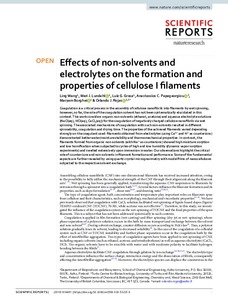Effects of non-solvents and electrolytes on the formation and properties of cellulose I filaments
Luiz G. Greca; Anastassios C. Papageorgiou; Maryam Borghei; Orlando J. Rojas; Ling Wang; Meri J. Lundahl
Effects of non-solvents and electrolytes on the formation and properties of cellulose I filaments
Luiz G. Greca
Anastassios C. Papageorgiou
Maryam Borghei
Orlando J. Rojas
Ling Wang
Meri J. Lundahl
NATURE PUBLISHING GROUP
Julkaisun pysyvä osoite on:
https://urn.fi/URN:NBN:fi-fe2021042822827
https://urn.fi/URN:NBN:fi-fe2021042822827
Tiivistelmä
Coagulation is a critical process in the assembly of cellulose nanofibrils into filaments by wet spinning; however, so far, the role of the coagulation solvent has not been systematically elucidated in this context. This work considers organic non-solvents (ethanol, acetone) and aqueous electrolyte solutions (NaCl(aq), HCl(aq), CaCl2(aq)) for the coagulation of negatively charged cellulose nanofibrils via wet spinning. The associated mechanisms of coagulation with such non-solvents resulted in different spinnability, coagulation and drying time. The properties of the achieved filaments varied depending strongly on the coagulant used: filaments obtained from electrolytes (using Ca2+ and H+ as counterions) demonstrated better water/moisture stability and thermomechanical properties. In contrast, the filaments formed from organic non-solvents (with Na+ as counterions) showed high moisture sorption and low hornification when subjected to cycles of high and low humidity (dynamic vapor sorption experiments) and swelled extensively upon immersion in water. Our observations highlight the critical role of counter-ions and non-solvents in filament formation and performance. Some of the fundamental aspects are further revealed by using quartz crystal microgravimetry with model films of nanocelluloses subjected to the respective solvent exchange.
Kokoelmat
- Rinnakkaistallenteet [19207]
